Finding the perfect meat grinder for your kitchen or business can be a daunting task. You might be asking yourself, “What size meat grinder do I need?”
With so many different sizes, styles, and features, it’s easy to feel overwhelmed. But don’t worry, we’ve got you covered.
In this comprehensive guide, we’ll discuss everything you need to know about meat grinder sizes, factors to consider, plate options, manual vs electric grinders, maintenance tips, top brands and models, accessories, and safety tips to help you make an informed decision and grind meat like a pro.
Short Summary
- Understanding meat grinder sizes and selecting the right size for desired grinding volume is essential.
- Standard meat grinder sizes range from 5 to 32, with different tasks and capacities expressed in pounds per hour.
- Factors such as type of meat, frequency of use, grinding volume & power motor should be considered when choosing a size. Accessories can increase versatility & efficiency.
Understanding Meat Grinder Sizes
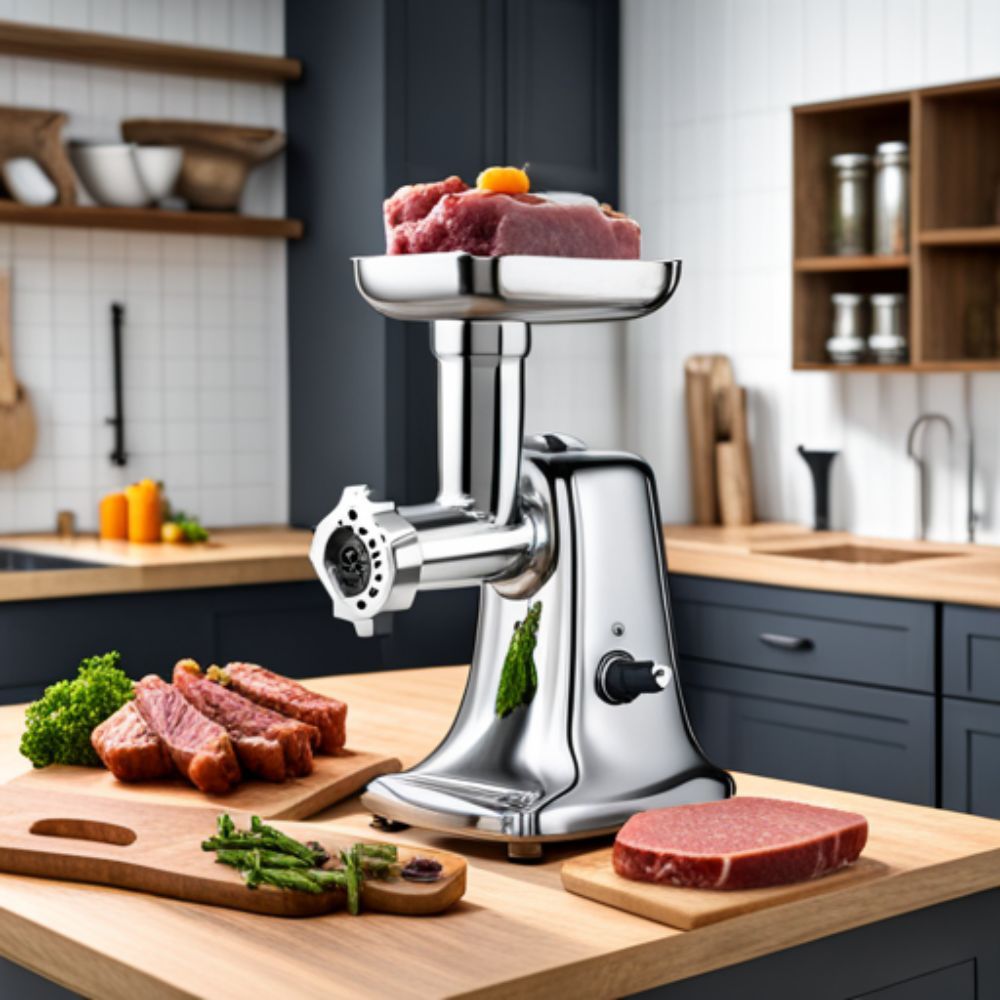
A stainless steel meat grinder with a grinding plate attached
Comprehending meat grinder sizes is essential for selecting the appropriate one for your requirements, especially when you need to grind meat efficiently.
The standard dimensions of stainless steel meat grinders are determined by the diameter of the outlet opening and the hub size, which can both be measured using the diameter of the grinding plate.
The diameter of the outlet opening is the size of the hole that the ground meat will pass through.
Standard Meat Grinder Sizes
The most common sizes of most meat grinders are:
- Size 5
- Size 8
- Size 12
- Size 22
- Size 32
Each size is designed for specific tasks and grinding capacities, which are expressed in pounds per hour. For instance, a size 22 meat grinder is recommended for grinding turkey necks, while a size 32 machine is optimal for more demanding tasks.
Most grinders are able to grind smaller animal bones and softer bones, such as chicken and rabbit bones, depending on the grinder plate size used.
Fine grind plates are suitable for producing ground beef, while medium grind plates are suitable for making sausage, and coarse grind plates are suitable for creating chunky ground beef.
How to Measure Your Meat Grinder Size
To measure your meat grinder size, you can follow these steps:
- Check the user manual or contact the seller for information on the size of your meat grinder.
- Use a ruler or caliper to measure the diameter of the grinding plate.
- Match the diameter of the grinding plate with a chart that outlines the hub sizes of various meat grinders.
- Determine the appropriate size for your needs based on the chart.
By following these steps, you can easily determine the size of your meat grinder.
Factors to Consider When Choosing a Meat Grinder Size
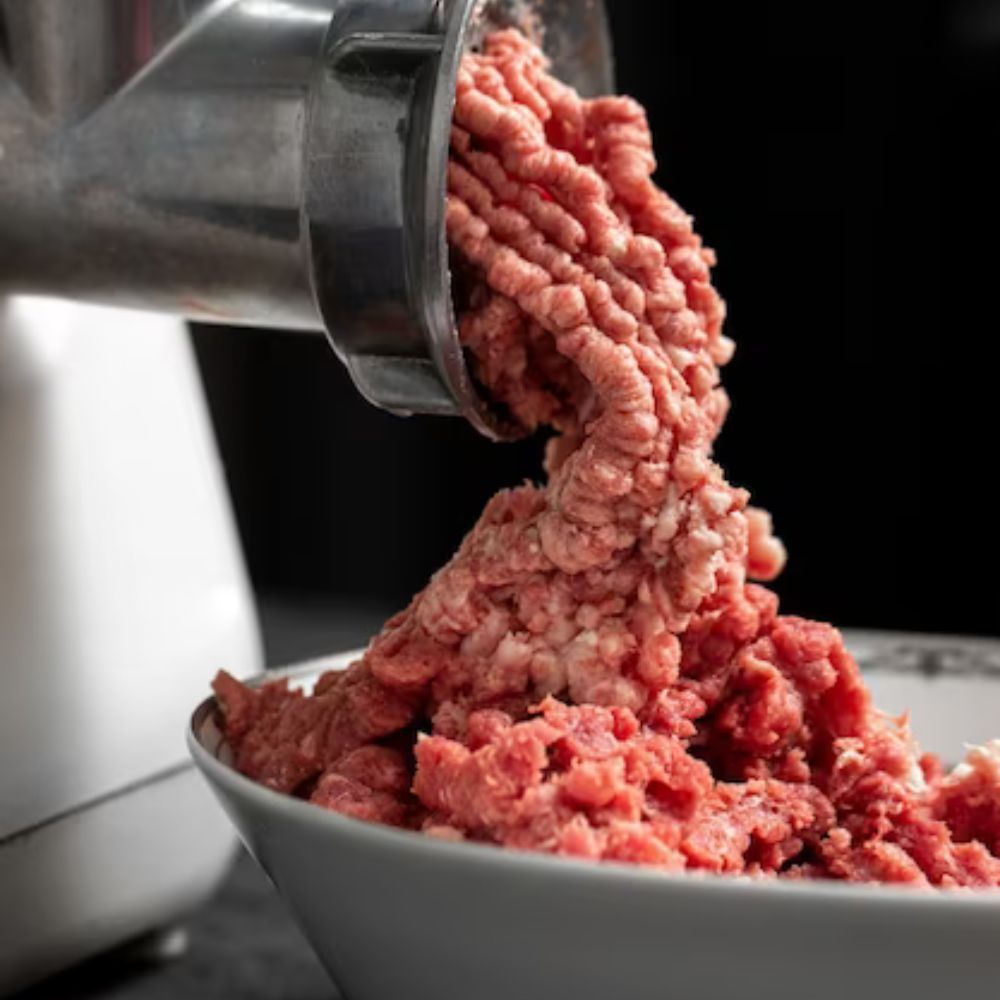
Meat grinder using a grinder plate
When selecting a meat grinder size, factors such as:
- the type of meat to be ground (including breakfast sausage)
- the frequency of use
- the grinding volume
- the power of the motor
Should be taken into consideration.
In the following subsections, we will discuss these factors in detail to help you make an informed decision.
Grinding Volume
Grinding volume is the quantity of meat that needs to be processed, with larger grinders being more suitable for larger amounts.
The dimensions of the meat grinder have a direct impact on its grinding capacity, with larger sizes being able to handle greater volumes at a faster rate (expressed in pounds/hour).
For example, a size 12 meat grinder is suitable for grinding less than ten pounds of meat at a time. Choosing the right meat grinder size for your grinding volume needs helps ensure efficient and consistent results.
Types of Meat
A commercial meat grinder is capable of grinding various types of meat, such as:
- beef
- pork
- lamb
- poultry
In addition to individual units, commercial meat grinders come in various sizes and capacities to suit the needs of different businesses.
Different types of meat may require different meat grinder plate sizes and options for optimal results.
For instance, fine grind plates are ideal for producing smooth and consistent ground meat products, such as hamburgers and franks, while medium grind plates are optimal for grinding fish and producing Italian sausage.
By selecting the appropriate grinder size and plate option, you can achieve the desired texture and consistency for a wide range of meat dishes.
Frequency of Use
The frequency of use for a meat grinder is dependent on individual requirements and preferences.
The more often you use the grinder, the more powerful and durable it needs to be. For example, a larger and more powerful machine is the most suitable size of a meat grinder for regular grinding of a considerable amount of meat.
On the other hand, if you only need to grind small amounts of meat occasionally, a smaller, less expensive grinder may suffice.
The choice ultimately comes down to personal preference and the specific needs of your kitchen or business.
Meat Grinder Plate Options and Their Uses
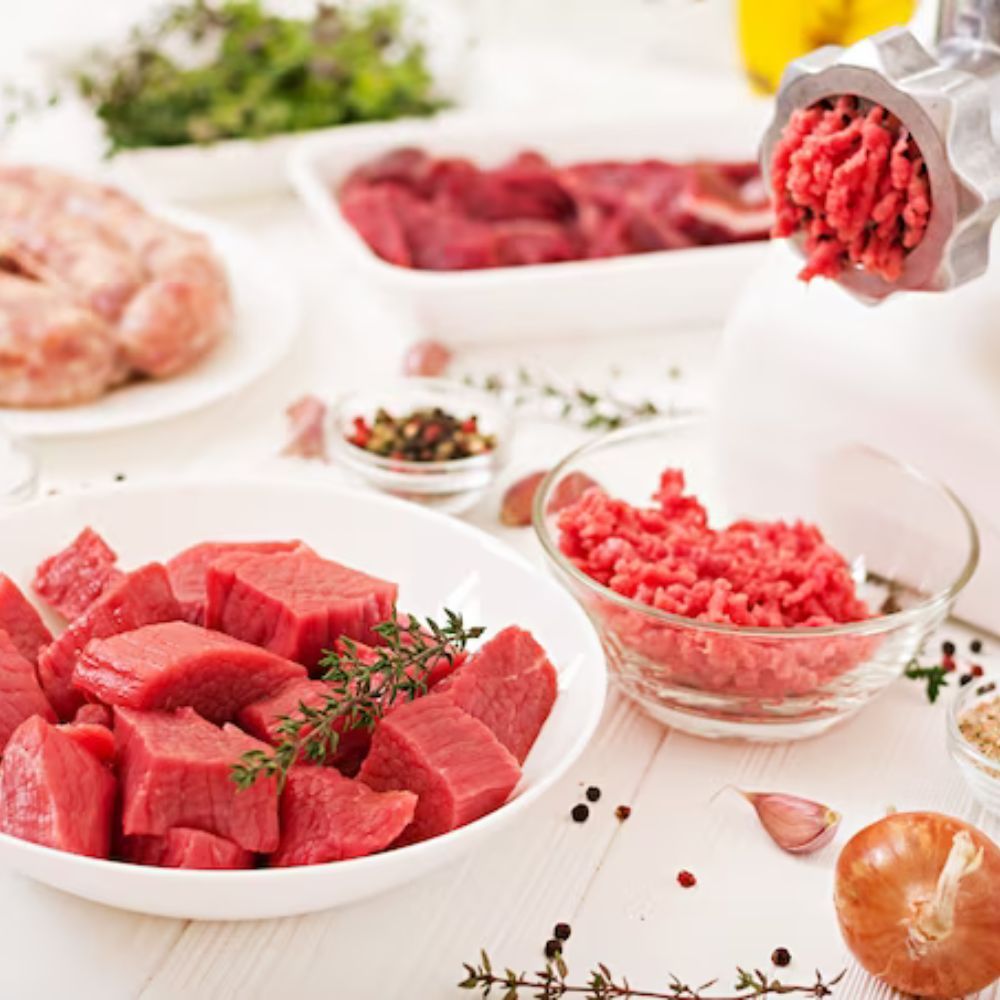
Dfferent types of foods that can be used in a grinder
Meat grinder plates are round carbon or stainless steel grinding plates that feature multiple holes, which are positioned at the end of the stainless steel meat grinder.
As the meat is forced through the holes of the grinding plate, a spinning blade cuts across the holes multiple times per second, creating ground meat with different textures depending on the hole size of the plate.
In the following subsections, we will discuss the different types of grinder plates and their uses.
Fine Grind Plates
Fine grind plates are a type of meat grinder plate with smaller holes, designed to produce a sausage of smoother texture with a finer consistency.
These plates are best suited for producing a smooth and consistent texture in ground meat products, such as hamburgers and franks.
By using fine grind plates, you can ensure that your ground meat dishes have the desired texture and taste that you and your family or customers will enjoy.
Medium Grind Plates
Medium grind plates are ideal for grinding fish and producing Italian sausage. These plates have larger holes compared to fine grind plates, which allows for a slightly coarser texture in the ground meat.
Using medium grind plates can help you achieve the desired consistency for dishes such as fish cakes, meatballs, and Italian sausage, adding versatility to your cooking repertoire.
Coarse Grind Plates
Coarse grind plates feature even larger holes than medium grind plates and are used to create coarsely ground meat. These plates are ideally suited for producing bratwurst, summer sausage, and snack sticks.
Using coarse grind plates allows you to create a wide variety of dishes with different textures and flavors, showcasing your culinary skills and satisfying the taste buds of your family or customers.
Manual vs Electric Meat Grinders: Which One is Right for You?
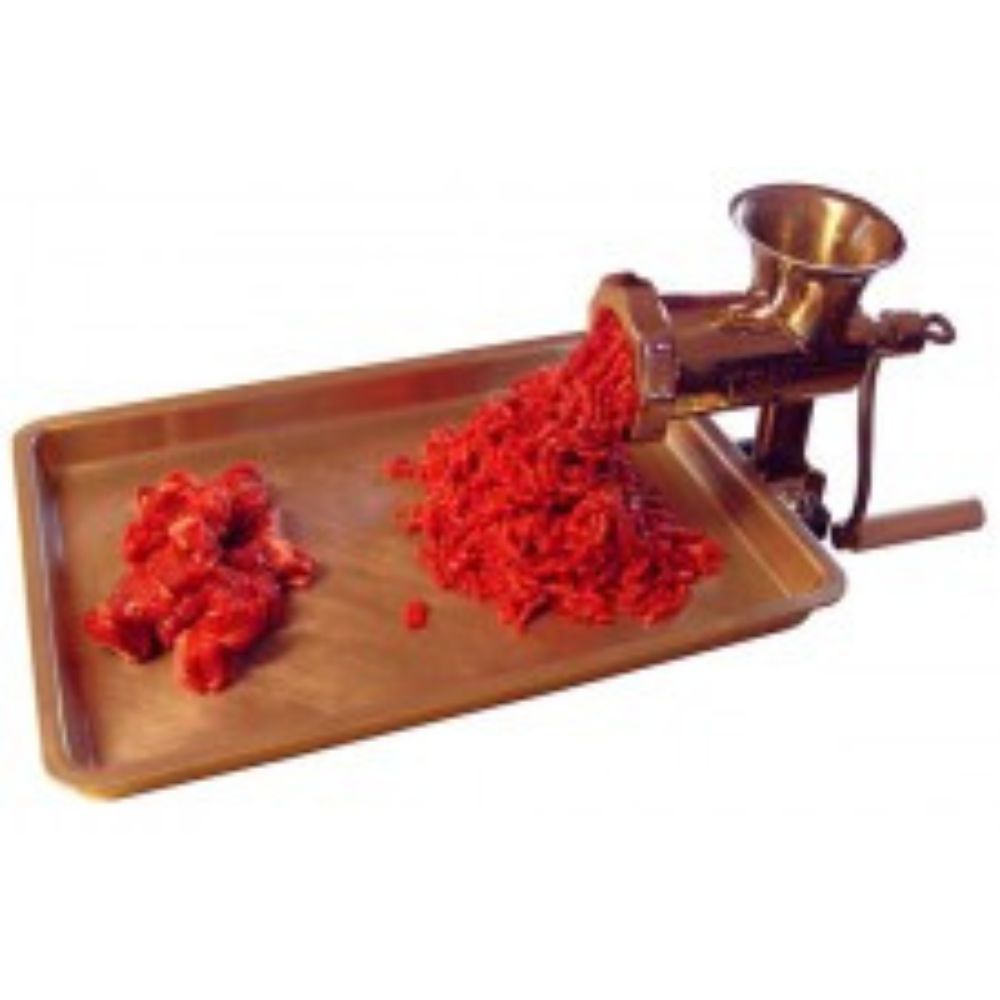
Manual meat grinder
Manual meat grinders require physical effort to operate and are suited for occasional use or locations without electrical outlets.
Electric meat grinders, on the other hand, are powered by an electric motor and are ideal for frequent or large-batch grinding.
Here are the key differences between manual and electric meat grinders:
- Manual meat grinders are typically more cost-effective and do not need electricity.
- Electric meat grinders are more convenient and require less manual labor.
- Manual meat grinders are not suitable for grinding large quantities of meat.
Consider your needs and preferences when choosing between a manual or electric meat grinder.
On the other hand, electric meat grinders are more expensive but require less manual labor and are suitable for grinding large quantities of meat.
The choice between manual and electric meat grinders depends on your specific needs, preferences, and budget.
Maintenance Tips for Meat Grinders
Proper maintenance of your meat grinder is essential for ensuring its longevity and optimal performance.
To clean the meat grinder after each use, use a damp cloth to wipe down the exterior and interior of the grinder, and ensure that all food particles are removed.
To prevent rusting of carbon steel plates, it is advised to keep them dry and occasionally apply a thin layer of oil.
When storing your meat grinder, ensure it is situated in a cool, dry area, and if feasible, place it in an airtight container to guard it from humidity and dust.
Top Brands and Models of Meat Grinders
Highly rated brands and models of meat grinders include:
- LEM
- PRO-CUT
- Thunderbird
- Waring
- Maverick
- Weston
These brands provide a variety of choices for different requirements and budgets. For example, Thunderbird meat grinders are equipped with solid stainless steel feed screws and headstocks, headstock rings, and meat trays, and all models operate on single-phase power.
The Maverick 5501 electric meat grinder is a highly-recommended compact tabletop grinder for home kitchens, featuring three sizes of meat grinder plates and a sausage stuffing tube.
By choosing a top brand and model, you can ensure that your meat grinder will provide reliable performance and lasting durability.
Accessories and Attachments for Meat Grinders
Various accessories and attachments, including sausage stuffers and meat mixers, can be used with meat grinders to increase their versatility and efficiency.
For example, metal food grinder attachments for Kitchen Aid stand mixers can transform your mixer into a versatile kitchen appliance that can grind and mince a variety of foods, including meats, vegetables, fish, and potatoes.
Sausage stuffing tubes enable the grinding of meat directly into casings for hot dogs and sausage, making the process more efficient and convenient.
By investing in accessories and attachments for your meat grinder, you can make the most of your kitchen equipment and create a wide range of delicious dishes.
What Size Meat Grinder Do I Need? - Meat Processing Equipment 301 - Walton's
Tips for Grinding Meat Efficiently and Safely
To grind meat efficiently and safely, it’s important to follow best practices. First, chill the meat and grinder parts before grinding to maintain the texture of the ground meat and facilitate the grinding process.
Second, always maintain sharp blades for efficient and even cutting of the meat, which leads to an improved texture and flavor.
Lastly, using the appropriate grinder plate size ensures that the meat is ground to the preferred texture, making your dishes taste just right.
By following these tips, you can ensure that your meat grinding experience is both efficient and safe, resulting in delicious, perfectly-textured dishes.
Are you in the market for a new quality meat grinder? Check out our article for our top picks.
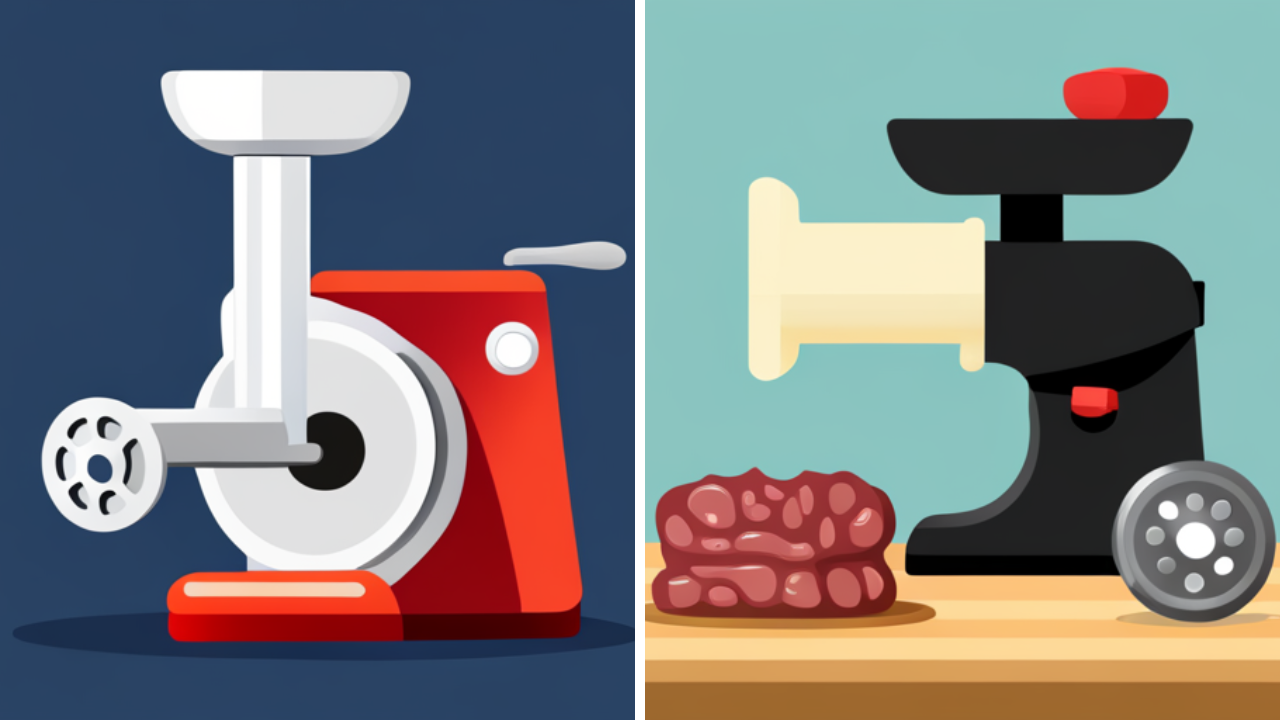
Summary
Choosing the right meat grinder size, plate options, and type of grinder is crucial for creating delicious and well-textured dishes.
By understanding meat grinder sizes, considering factors like grinding volume, types of meat, and frequency of use, and maintaining your grinder properly, you can ensure optimal performance and longevity of your kitchen equipment.
Whether you’re a home cook or a professional chef, investing in a quality meat grinder and its accessories will make your culinary creations even more delectable and satisfying.
Frequently Asked Questions
How do you size a meat grinder?
To size a meat grinder, use 3/4” for very coarse grinds, 1/2” for coarse grinds, 5/32” to 3/16” for medium grinds, and 3/32” to 1/8” for fine grinds.
This will yield optimal results for hot dogs, burgers, sausages, chili, stew meats, chorizo, and more.
What is the difference between a 10 and 12 meat grinder?
The main difference between a 10 and 12 meat grinder is that the #10 is a clamp style and the #12 is a bolt down design.
What size meat grinder blade do I need?
For most grinders, a 4.5mm plate is the standard size for grinding beef and other meats. This is usually the most common size recommended by grinder manufacturers.
What size grinder plate for hamburger?
For hamburger meat, an 1/8” grinder plate is the most common option.
Other sizes that may be used include 5/32” for hamburgers in Texas.
What is the significance of cooling the meat and grinder components when grinding meat?
Cooling the meat and grinder components before grinding helps to maintain the texture of the ground meat, and improves the efficiency of the grinding process.










